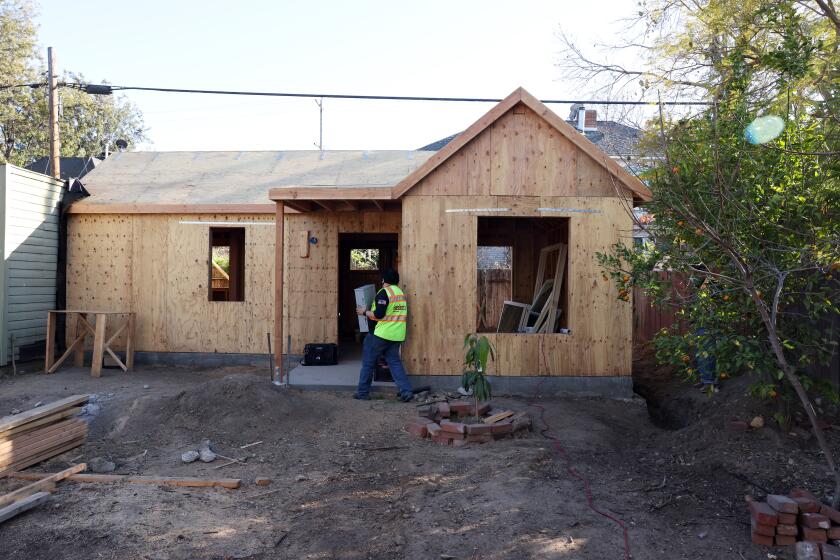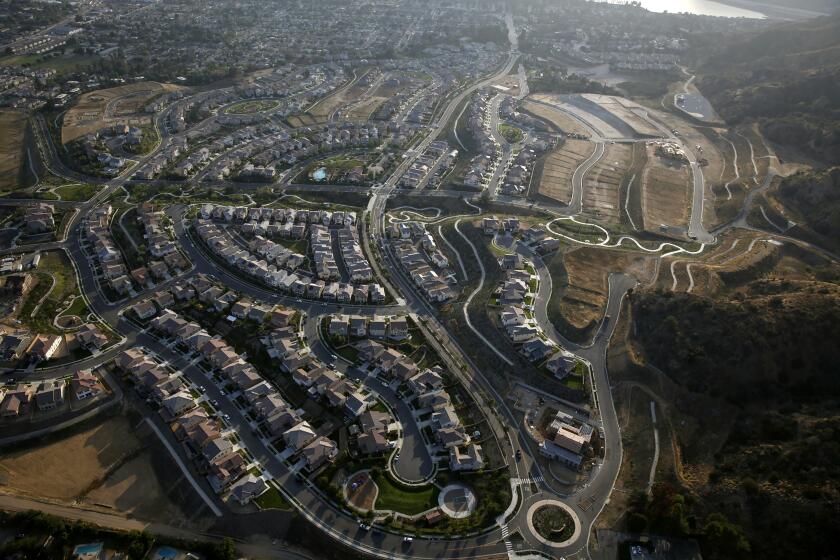Editorial: Watch out, NIMBYs. Newsom just dumped single-family zoning

In one of his first moves after surviving the recall, Gov. Gavin Newsom took his boldest steps yet to fix California’s housing shortage by signing a package of bills that will transform the state by getting rid of single-family zoning and making it easier to build the housing the state so desperately needs.
Of the three housing bills Newsom signed Thursday, the most consequential is Senate Bill 9 because it will allow up to four units of housing on a single-family lot. Another, Senate Bill 10, creates a voluntary program that makes it easier for cities to upzone any urban or transit-adjacent parcel of land, including a single-family lot, to allow a building of 10 units or fewer.
These were controversial bills because single-family neighborhoods have long been held as sacrosanct. But there is a growing recognition in California and beyond that we cannot build enough new housing to meet the needs of the population or in the places we need it most, such as near job centers, good schools or transit, as long as multifamily housing is excluded from two-thirds of the state’s residential land.
California has already passed laws in recent years that allow homeowners to build three units on their property — a house and two granny flats. SB 9 allows one more unit than existing law. It will also give property owners more options in what types of units they build and will allow them to split the lot and sell — not just rent — the new units. These are important changes that legalize a style of construction that used to be quite common in some cities — duplex, triplex and fourplex apartment buildings — next to single-family homes. But SB 9 still has some restrictions. It will not apply in historic districts or in environmentally sensitive areas, like wetlands and certain high fire-risk areas. It also will not apply if a house has been occupied by a renter within the last three years, a provision intended to prevent tenant displacement.
Two fairly modest proposals to allow greater housing density are under debate in Sacramento. They shouldn’t be controversial, and yet they are.
Newsom also signed Senate Bill 8, which extends to 2030 a temporary law that speeds housing development approvals and requires that a developer replace any rent-controlled or affordable units that are demolished for new construction.
Kudos to Newsom for not dillydallying on these important bills. The housing shortage is central to so many of California’s most pressing problems: homelessness, poverty, income inequality, clogged freeways and pollution from vehicles driven on long commutes. The state needs to add between 1.8 million and 2.5 million homes by 2025 to ease the housing shortage that is driving up rents and home prices.
In polls and during the lead-up to the recall election, Californians repeatedly cited the state’s unaffordable housing and its corollary, the homelessness crisis, as their top concerns. And this was one area in which Newsom and the leading candidates to replace him all agreed: California must make it easier to build housing.
But when it comes to solutions, there’s less consensus — and political courage. The recall candidates were all eager to rail against the housing shortage, but they adamantly opposed bills to ease local restrictions on development or loosen single-family zoning. That’s a problem. For decades, many local governments have shirked their responsibility to permit more housing, bending to slow-growth, not-in-my-backyard groups that don’t want to make room in their communities for more residents.
That’s why Newsom, along with Senate President Pro Tem Toni Atkins and Assembly Speaker Anthony Rendon, deserves credit for pushing Californians out of their comfort zone. Atkins and the Senate, in particular, have come up with proposals to encourage, prod and even force communities to make it easier to build. Land use traditionally has been the domain of local government, but the reality is that California will never build enough housing as long as cities use their local control to maintain the status quo.
Newsom has been far more aggressive on housing than former governors. He’s budgeted billions of dollars to build more housing for low-income and homeless Californians and to help cities rezone and streamline approvals to speed up housing development. He’s also stepped up enforcement of state housing laws, including creating a new Housing Accountability Unit in his administration to both track cities’ progress and to help them fulfill their obligations to plan for more homes.
Gov. Gavin Newsom signed legislation that allows more than one unit to be built on lots zoned for only one. It sounds technical, but it’s a major change in California housing policy. Here’s what it means.
Newsom’s decision to sign these housing bills is a natural step in trying to fix California’s broken housing system — and it’s one being watched by other states. Across the nation, about 75% of residential land is zoned just for single-family homes. President Biden and his economic advisors have warned that restrictive zoning widens the racial wealth gap and hurts upward mobility.
Restrictive zoning has its roots in racist public policies. Single-family zoning was often adopted over the last century as a way to segregate neighborhoods without explicitly banning any racial or religious group. Today, restrictive or exclusionary zoning perpetuates racial and economic segregation by prohibiting lower-cost apartments and town homes in high-opportunity single-family neighborhoods with good schools, parks and other amenities.
California has a lot of work ahead to untangle the red tape and restrictions that have stymied home construction. Newsom gets credit for being ambitious and aggressive on housing. Now he just needs to persuade more California communities to come along.
More to Read
A cure for the common opinion
Get thought-provoking perspectives with our weekly newsletter.
You may occasionally receive promotional content from the Los Angeles Times.












